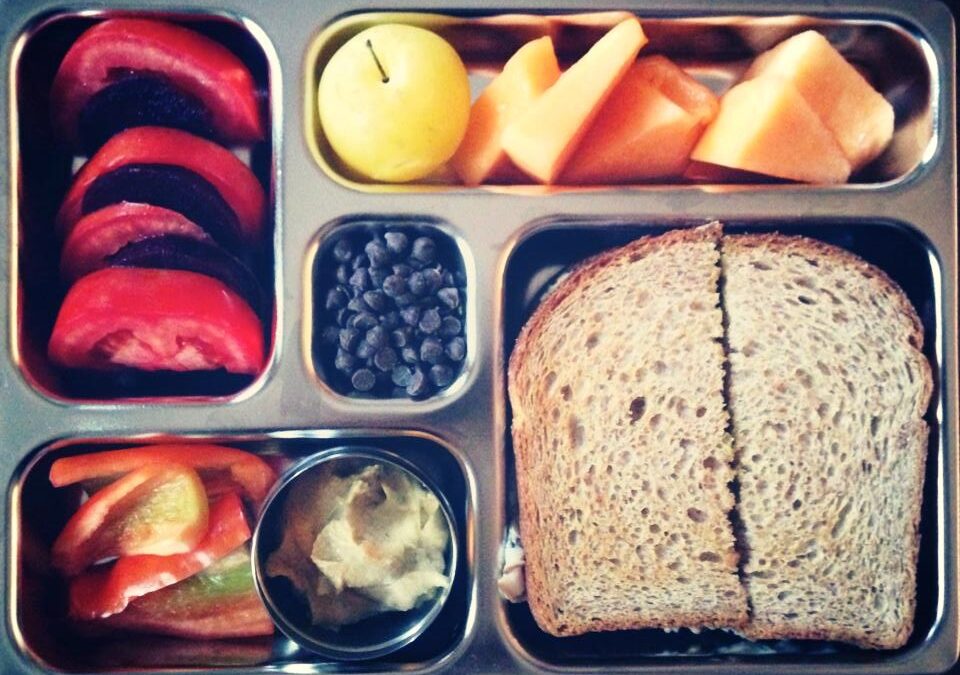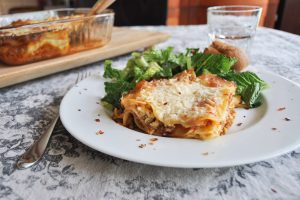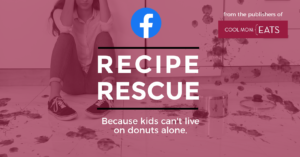One of the most popular requests that we get is for easy school lunch recipes. While we’re happy to oblige — from gluten-free school lunch ideas to creative ideas for how to pack veggies in school lunch, sandwich alternatives to high protein school lunch ideas (and pretty much everything in between) — the truth is that the magic isn’t in the recipes. Rather, it’s in your pantry.
When you pack your pantry and fridge with the versatile ingredients on our essential school lunch shopping list, pulling together a creative school lunch — or 180 of them — becomes much easier. Get the list and tons of ideas for how to use each item below.
This is our annual update of a post originally published in 2016.
Related: DIY Lunchables, because hello cheaper and healthier.
The Essential School Lunch Shopping List:
Protein

Protein is the primary part of any good lunch, not just because kids need it to grow strong. It also goes a long way to keeping you full and balancing blood sugar, which helps kids endure a long, active school day without crashing. Most parents fall back on animal protein, but there are plenty of dairy and plant-based protein sources, too, that are especially great when combined (one of our favorite healthy yogurts + a seed butter sandwich). Even chia seeds have a surprising amount of protein, so you can use them to boost the overall protein content of your kid’s lunch as well.
Eggs
I cannot live without eggs, much less pack school lunch 180 times without them. Mostly, I make a big batch of steamed eggs (they’re like hard boiled, but so much better and easier!) to slice or turn into egg salad sandwiches. Or I halve them to serve alongside veggies and hummus, ham roll ups, or even a muffin like in this fantastic gluten-free lunch idea.
On those (rare) mornings when I wake up early, I might even scramble eggs — sometimes with pesto (yum!) — for an egg sandwich or breakfast-for-lunch treat. Another great idea: these make-ahead Spinach Egg Bites.
Lunch meat
Lunch meat is the easiest way to add protein to a school lunch; sliced ham, turkey, roast beef, and turkey pepperoni also save me during the school year. Sandwiches are great, but sometimes I just roll them up plain or with a slice of cheese to go with pretzels, pita chips, or our favorite healthy tortilla chips to change things up. It’s quick little changes in presentation like this that make lunch feel more exciting.
Canned tuna
Seafood is a super healthy protein, but with all the talk about mercury it can be hard to know if canned tuna is safe. Your best bet is to stick with a safe brand like Safe Catch or Wild Planet, which also makes a tasty canned chicken (it’s true — we tried it!).
Hummus
Beans are a wonderful, (mostly) kid-friendly, plant-based source of protein and hummus is a great way to serve them easily. For little kids especially, hummus paired with a bunch of veggies and pretzels or crackers makes a great lunch main; if you have an older kid who needs more heft, include a cheese stick, a hard boiled egg, a few slices of turkey pepperoni, or use dinner leftovers to throw together this Chicken Hummus Bowl.
Also, my kids love hummus sandwiches. When I’m in a rush, it’s just bread and hummus; when I have more time, I’ll pile on veggies too. A few companies like Hope Foods have also started making “hummus” using lentils and black beans, so look out for those as well.
One more thing: If you’re looking for a creative way to serve hummus, you have to check out this brilliant DIY Mason Jar hack. So smart!!
Beans
Canned beans are a pantry staple that I pull out just as much for lunch as I do for dinner. Black beans and thawed frozen corn get turned into a quick black bean salad or salsa for topping leftovers, and chickpeas get tossed with chopped veggies to make a salad or with rice to make a quickie grain bowl. I also love making roasted chickpea snacks that are sweet, but secretly give a boost of protein. A win-win.
Cheese
Cheese is a great source of protein and, when presented right, can serve as a lunch main. In fact, one of my older son’s favorite lunches used to be a “cheese plate lunch,” which includes: hunks of two kinds of cheeses, pickles, grapes and apples, sliced baguette, and sometimes ham. (He’d still love this today, by the way, but has developed a lactose intolerance — boo!)
You can also add cheese to a lunch box-friendly salad like in this Chopped Greek Salad or lunch box Caprese Salad.
Cream Cheese
This is not a major source of protein by any stretch, but I include it here to encourage you to think beyond meat and nut or seed butter as the go-to sandwich spreads. My little one loves a cream cheese and jelly sandwich and his number one favorite school lunch is cream cheese and shredded carrots or sliced cucumbers.
Yogurt
If you have a filling carb, like maybe these make-ahead (and freezer-friendly) Ham and Cheese Muffins, yogurt, particularly protein-rich Greek-style, can serve as a filling accompaniment. You can also turn Greek-style yogurt into a fun and healthy lunch box dip that goes great with pita chips and maybe some leftovers. If you’re looking for some new brands to count on, here’s our list of favorite yogurt brands to pick up at the supermarket.
Quinoa
Many of you probably think of quinoa as a carb. Though it certainly functions that way in cooking, quinoa is actually a protein-rich seed that you can use to make cold lunch box salads, fill wraps or burritos, or turn into quick and easy lunch box grain bowls.
If you’re worried about how your precious eater will react to eating quinoa, start by serving it at dinner first (make enough to have leftovers for school lunch) and definitely use our tutorial for how to cook quinoa, which yields a fluffy, mild-tasting quinoa that kids are much more likely to accept.
Cottage Cheese
If your kids eat it, cottage cheese is a nice way to switch things up. You can serve it sweet or savory. My kids like it best with fresh fruit and a drizzle of honey on top.
Nuts and nut butter (if allowed)
For years, parents have relied on nuts and nut butter — peanut butter in particular — as an easy, healthy, plant-based source of protein. There’s no reason to abandon peanut butter if it’s safe for your child and allowed in your school. PB&J’s are great, but also think beyond the sandwich. My kids love this Peanut Butter and Jelly Chia Pudding that we found at Minimalist Baker and I often make these No-Bake Energy Bites that we found at Gimme Some Oven with peanut butter.
If peanuts and tree nuts are not allowed in your school, pleasenut-free spreads abide by your school’s food allergy policy. They are made to make everyone safe, and there are plenty of that you can use as an alternative.
Tofu and edamame
If you’re not big into a vegetarian diet, maybe you didn’t know that tofu and edamame are both protein-rich soy. You also may not know that soy is high in estrogen, as well, and that some people feel a diet very high in tofu is actually unhealthy. In countries where soy is eaten in smaller quantities though (as in, not eaten in a huge veggie burger made to compete with the size of our huge hamburgers), tofu and edamame can be both delicious and a healthy hit of protein. So cube it up or throw some thawed frozen edamame into your little one’s lunch box to change things up every once and a while.
The Essential School Lunch Shopping List:
Carbs

Carbs go without saying, right? After all, sandwiches are the staple of most school lunches. You probably don’t need all that much help with this one, but the big takeaway is to think beyond the sandwich. You can also roll things up in a tortilla, layer things over grains, dress up pasta, serve things alongside chips, or let your eater pile things onto crackers to keep lunch interesting.
Bread
You have this one, I know, but sometimes move beyond sliced sandwich bread. Leftover sliced chicken with baguette. Ham and cheese on a pretzel roll. Garlic knots with sliced pepperoni or salami on the side. These small adjustments make a big difference when you have nearly 200 lunches to pack. And of course, there’s always gluten-free bread, too, if your child can’t tolerate the big G.
Tortillas
My kids are happy to eat room temperature quesadillas, so I often use tortillas for that (because spinach goes down without a fuss when it’s all melty with cheese), but you can also use tortillas to make wraps (veggie and hummus), tacos (leftover roast chicken or pork with chopped tomatoes, lettuce, and salsa), burritos (leftover rice or quinoa with black beans, cheese, and sliced avocado), and roll ups of all kinds (even just peanut butter or sunflower seed butter and banana!).
Grains
I used to make these lunch box grain bowls only when I had leftovers, but my kids love them so much that I’ve started making and freezing big batches of quinoa specifically to make them. I freeze the quinoa in small quantities in sandwich-size storage bags and quick thaw them in the morning. Then I layer on whatever else I have on hand and drizzle the whole thing with a dressing. If you make our favorite easy vinaigrette at the beginning of the week and keep it in the fridge, this will always be a quick and easy lunch box solution.
Pasta
Whenever you make pasta for dinner — which is, what, once a week? — always make extra for lunch the next day. It’s a no-brainer, especially if your kids are like mine and thrilled to see pasta with butter and peas (the frozen kind) in their lunch box. Here are our directions on how to cook pasta ahead of time if you want to cook a batch specifically for school lunches.
Crackers
Who doesn’t love a good cracker appetizer? Skip the sandwich and take inspiration from your favorite h’ordeuvres instead or crib one of these 24 fast, healthy ideas to top crackers for kids.
Pretzels and pita chips
Serve deli meat with a side of pretzels and watch the same ingredients that get left behind in a soggy sandwich get gobbled up. Or skip the meat and make a meal of one of these protein-rich lunch box dips with a favorite carb dipper on the side.
Related: 9 healthy dips for school lunch sandwich alternatives that your kids will love.
The Essential School Lunch Shopping List:
Fruit

Fruit is a gimme in any lunch box: Unless you have a fruit refusnik (I hear they exist), most kids have some sweet fruit that they love, or are at least willing to eat. To keep it interesting, though, try not to just pack apples day after day. . . after day. There are so many more options, and even super creative ways to pack fruit in a school lunch.
Grapes
They come in several colors and you can easily pop ’em in your mouth — perfect for little eaters. Look for seedless and serve them plain or maybe even dipped in chocolate. Yes!
Apples
Of course, apples. But don’t get stuck in a rut. Buy apples of all different colors, cut them up into fun shapes using cookie cutters, or serve them with a peanut butter dip, which you can also make with seed butter, by the way.
Pears
Pears are just as delicious as apples and can be served in many of the same ways, so why not change it up when you can.
Dragon Fruit
It’s crazy, I know, and probably on the expensive side, too, but when you need to get out of a rut, try picking up an unusual tropical fruit for your kids to try. The amazing look of this black and white speckled fruit (above) may at least get kids to give it a try.
Prickly Pear
This is another exotic fruit that I pull out every once and a while. The bright pink color always mesmerizes my kids. The only catch: It can stain too.
Star Fruit
Of all the exotic fruit you might grab, this is the best, because stars! Little kids will delight in how this looks (if not tastes) in their lunch box.
Passion Fruit
I admit that this one is tricky, but my older son loves it, and you can easily include it by cutting it down the middle and packing an entire half. They can scoop the oozy, flavorful pulp right from the fruit into their mouth or maybe mix it into some plain yogurt. The texture alone makes it feel like a science experiment!
Mango
We’re totally obsessed with mango in my house and cannot imagine anyone not liking the flavor. If you or your kids are not sold, though, maybe a fun presentation will help? Follow our quick video tutorial on how to cut a mango and then pack one of the scored halves, cut side down, in your little one’s lunchbox. Maybe they’ll become a mango fan after all.
Bananas
Kids and bananas, right? To keep it from getting brown and mushy, just cut one in half and pack it in a hard sided case. Your kid can peel and eat at lunch time.
Strawberries, blueberries, raspberries, and blackberries
Though they are (way) better in summer, most places have access to some variety of berries all year around. Skip them when they are hard and sour, but my kids love them even when they are just a little bit sweet. Sometimes, I’ll pack them with a side of citrus sugar for dipping. Just be aware that texture-sensitive kids may not like when berries get squashed: My kids prefer berries that are slightly more sour, but firm enough to keep their shape in a lunch box that gets thrown around. Go figure.
Pomegranate
Pomegranate arils save me in the winter when it’s apples and pears, pears and apples, over and over. My kids have grown so fond of these tart seeds that I’ve taken to serving them alone with a spoon to scoop them up. (Thank goodness for prepackaged arils so that I don’t have to extract all those seeds myself — though if you like the challenge and it saves money, here’s how to cut a pomegranate — and other hard to deal with fruit too).
Cherries, peaches, nectarines, apricots, plums, and other stone fruit
When in season — which, I admit, is only for a relatively short part of the school year — there’s nothing better than packing fresh stone fruit. Most of these fruit can be cut in half, pitted, and packed plain for a delicious treat. As for cherries, my kids manage the pits themselves, but if you’re packing lunch for a little one, consider pitting them ahead of time with the awesome cherry pitter (there’s such a thing!) that we use to help get kids excited about helping in the kitchen.
Melon
You can usually find some kind of melon nearly all year around. Cut the melon in cubes ahead of time to have it ready and waiting in your fridge. And — here’s a tip — use a melon baller to change up the shape! I know that it may seem like a small thing, but it’s exactly these kind of small changes in presentation that can make a big difference to little ones.
Related: 7 creative ways to pack vegetables for school lunch so that kids actually try them.
The Essential School Lunch Shopping List:
Vegetables

Ah, vegetables. Probably not the most popular part of lunch, but as I see it, an essential thing to pack every single time. I know that it can be frustrating to pack up good veggies only to have them come back (or maybe “secretly” land in the cafeteria garbage bin), but if you can afford to take the chance, packing them every day makes the point that veggies are an important part of a balanced meal — even at lunchtime.
Also, if your kids eat some veggie at lunch, it releases some pressure for them to eat a day’s worth at dinner when they are tired and you’re (possibly) hovering over them. Even just a little bit of autonomy to decide what veggies they will and will not eat out of your line of sight might make a really positive — if slow moving — impact.
To keep the veggie thing interesting and hopefully pique the interest of your independent lunch eater, make sure that the veggies are fresh, crisp, and colorful. Remember: We eat with our eyes too! And don’t be afraid to add flavor: sprinkle on some salt, top with a dash of sesame seeds, add a dip, and find other ways to make veggies as appealing as possible. Here are some creative ways to pack veggies in school lunch.
Avocado
Many kids like avocados because they’ve been eating them since they were very little. If your child qualifies, don’t be afraid of browning — there is a way to pack avocado in a school lunch so that it stays fresh and appealing. Just follow my foolproof how-to for the details.
Bell Peppers
These are a go-to for me because they are such an easy way to add vibrant color to my kids’ lunchbox.
Cucumbers
Change up the way you cut these: “wheels” one day, “sticks” another, sometimes the peel on, sometimes the peel off. Keep changing it up or experiment until you find what works.
Carrots
The number one lunch box veggie in my house: shredded carrots. Somehow, serving them that way gets my kids to eat them every time. I make shredded carrot and cream cheese sandwiches a lot, and sometimes even toss the carrots with a little oil, vinegar, salt, and raisins for a quick salad. Of course, we sometimes do carrot sticks and “wheels” too.
Radishes
I know this is unconventional, but my older son loves radishes. If you have a kid who likes spicy food (interestingly, quite a number of kids with sensory challenges like spicier food because it’s a strong sensory input), give radishes a try. Slice them thin to keep the flavor more mild or cut in half and serve with softened, salted butter as a dip. Oh la la.
Cherry Tomatoes
Cherry tomatoes are easy to get all year long, come in varied colors, and they are the perfect “snack” size for lunch boxes. Plus, they’re sorta sweet. Mmm. If your child likes a classic tomato mozzarella salad, drizzle olive oil and sprinkle salt over cherry tomatoes and bocconcini, those small round balls of mozzarella for a fun shaped lunch box salad.
Snap or Snow Peas
Between the two, you can find these in the market for a good part, if not all, of the school year. Both can be sweeter than bitter and served raw. Hey, it’s worth a try: If your kid eats them, that’s one green veggie down.
Celery
A classic for good reason. Serve plain, alongside hummus, or smeared with nut or seed butter and dotted with raisins.
Related: The best healthy back-to-school snacks (that happen to be gluten-free too!).
The Essential School Lunch Shopping List:
Snacks

There are (way) too many snack foods in the supermarket to mention here, plus I’ve mentioned a whole bunch in the carb section since things like pretzels and pita chips help keep me out of the sandwich rut. Fill in your favorites, but I wanted to share a few maybe unexpected items that are a little healthier than typical packaged snack foods so that you can go beyond those fruit snacks, cheddar bunnies, and cookie snack packs. This list of best back-to-school snacks is helpful too.
Popcorn
Popcorn can be super healthy, especially if you make it at home, which is super easy with our tutorial on how to make DIY microwave popcorn. Popcorn totally feels like a snack to kids, and no sugar. Perfect.
Lentil, bean, or (even) quinoa chips
If you’re going to pack something crispy, salty delicious, why not make it something made out of a healthy, high-protein ingredient like lentils, beans, or quinoa. We’ve been longtime fans of both the Beanitos Bean Puffs and Simply 7 Quinoa Chips that we included on a list of best high protein snacks. The quinoa chips are still available, while Beanitos replaced the Bean Puffs with 100% baked Mac N’ Cheese Crunch, which are also packed with fiber and protein. And even I cannot get enough of the Maya Kaimal Chickpea Chips that were a big healthy snack food trend a couple of years ago.
Homemade granola gars (or our new favorite allergy-friendly granola snacks)
Making homemade granola takes some effort, but not as much as you may think, and you can freeze the granola bars to have on hand. These are our favorite granola bar recipes, but if you just don’t have the time — or inclination — try our new favorite store-bought granola snacks (hint: they’re totally allergy-free, which makes them safe for any school). I also love the allergy-free granola bites from Made Good that I included in my list of fantastic on-the-go snacks.
Squeeze pouches
I might be beyond baby food squeeze pouches, but we still buy snacks that come in the same convenient packaging. Not all squeeze pouches are as healthy as they seem, so definitely check the label. My kids love the Mamma Chia Squeeze Packs and GoGo Squeez Yogurtz that I included in my list of favorite on-the-go snacks and, bonus, neither require refrigeration.
Dried fruit
While you don’t want to overdo dried fruit, because it’s actually pretty high in sugar, its natural sweetness can serve as a satisfying sweet bite in a lunch box. My kids love cherries, apricots, cranberries, and mango best. If sugar is something you watch, look for all-natural dried fruit that doesn’t have added fruit juice or other sweeteners. My kids — yes, even the 1o-year-old — still loves the Peeled Apple Clusters that we includes on a past back-to-school snack list, but if you ask me, all of their stuff is great.
Freeze fried fruit (and veggies too!)
Freeze dried fruit and veggies are great because they are relatively low in sugar and retain much of the fruit or vegetable’s original nutritional make up. Plus, it’s like space food (or at least that’s how you can get a skeptical kid to try it!). We’re fans of Crispy Green snacks, which we included a past list of best back-to-school snacks.





